Exploring Large Amethyst Geodes: Beauty and Significance
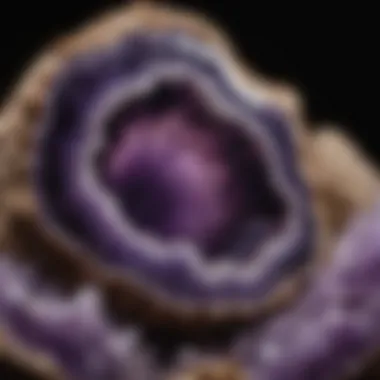
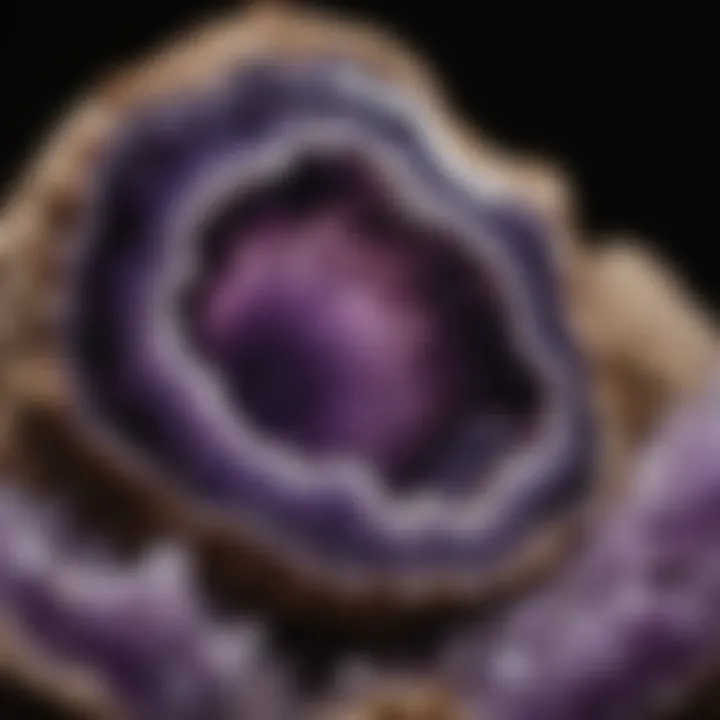
Intro
Large amethyst geodes captivate the attention of collectors and enthusiasts alike. Their unique structure and dazzling crystals offer not only aesthetic beauty but also insight into geological processes. Understanding these intricate formations requires an exploration of their characteristics, formation process, and the significance they hold for collectors.
Amethyst, a variant of quartz, is known for its rich purple hue, which ranges from light lavender to deep violet. This coloration enhances the appeal of large geodes, making them highly sought after. Collectors desire them not just for their beauty but also for their geological narrative, which tells a story of deep Earth processes and mineral formation.
Through this article, we will engage with a detailed examination of large amethyst geodes, from their formation to their relevance in the collecting community. We will cover essential care techniques to preserve their beauty for years to come, as well as strategies to identify and authenticate these geodes.
Featured Collectible of the Month
Overview
This section shines a light on notable large amethyst geodes currently gaining attention among collectors. These geodes stand out due to their quality, size, and history. Recently, some spectacular finds have surfaced, particularly from regions like Brazil and Uruguay. These geodes showcase prominent clusters of amethyst crystals, often drawing interest in auctions and exhibitions.
Historical Significance
The historical backdrop of amethyst geodes enriches their value. In ancient civilizations, amethyst was revered as a stone of protection and clarity. Greeks used it for its believed ability to prevent intoxication, while in the Middle Ages, it was associated with the ecclesiastical community. The extraction practices of amethyst have evolved over centuries, making specific geodes particularly notable due to their age and the methods used in their uncovering.
"The allure of amethyst is not just its color but also its enduring history connecting cultures across the globe."
Identification Techniques
Visual Characteristics
Identifying large amethyst geodes requires an understanding of their visual features. Look for the following characteristics:
- Color: Ranges from light lilac to deep purple.
- Crystal formations: Well-defined crystal clusters are a positive sign of quality.
- Cavity size: Larger cavities with well-formed crystals are typically more desirable.
- Surface texture: The outer layer may appear rough, encasing the crystal-lined interior.
Resources for Identification
For those interested in deepening their understanding or verifying their specimens, several resources can enhance the identification process. Websites such as Wikipedia provide comprehensive geological insights. Other platforms like Reddit and Facebook host vibrant communities where collectors share information and experiences, making them perfect for seeking expert advice.
Definition of Large Amethyst Geodes
Understanding large amethyst geodes is essential for anyone interested in geology or collecting minerals. Geodes are often fascinating because they encapsulate natural beauty and geological processes. Describing large amethyst geodes involves explaining what makes them unique and valuable.
What Constitutes a Geode
A geode is typically a hollow, rock-like structure filled with crystals or mineral matter. Most often, these structures are formed within volcanic or sedimentary rocks. The formation begins when mineral-rich water seeps into cavities within a rock formation. Over time, the minerals within the water begin to crystallize as they settle. In the case of amethyst geodes, the predominant mineral is quartz infused with iron, which gives amethyst its distinctive purple hue.
The outer layer of a geode is usually made of a hard rock shell such as chalcedony or agate. However, geodes can vary significantly in size, ranging from just a few centimeters to more than a meter in diameter. The size of large amethyst geodes can make them highly sought after by collectors. Notably, the average crystal length within these formations can extend several centimeters.
Characteristics of Amethyst
Amethyst is a variety of quartz known for its rich purple color, which is due to the presence of iron and other trace elements. It is one of the most beloved gemstones used in jewelry and decoration. The depth of the purple can vary. Some amethyst may appear very light, while others exhibit a deep, almost royal hue.
In addition to their aesthetic appeal, amethyst crystals exhibit a unique hexagonal crystal structure. This arrangement contributes to their stunning appearance and is a result of the conditions under which they form. Crystals can also display inclusions and color zoning, which can enhance their visual interest and value.
Fans of geology and crystal collecting frequently appreciate amethyst not only for its beauty but also for its historical context. Ancient civilizations valued amethyst for its purported protective qualities and believed it to be a symbol of wealth and refined taste.
"Large amethyst geodes represent a fascinating intersection of geology, mineralogy, and artistry—all of which contribute to their allure in both scientific and collector communities."
In summary, large amethyst geodes embody a complex interplay of geological formations, mineral properties, and cultural significance, making them a compelling subject for enthusiasts and collectors.
Formation Process of Amethyst Geodes
Understanding the formation process of amethyst geodes is crucial for grasping the unique characteristics and beauty of these geological structures. The process reflects not only the complexity of mineral development but also the myriad factors that influence the appearance of amethyst crystals. By exploring the genesis and growth of these geodes, collectors can appreciate the unique stories encapsulated within each structure.
Genesis of Geodes
The genesis of geodes involves a combination of geological and environmental factors. Geodes typically form in volcanic or sedimentary rock. When gas bubbles or cavities occur due to volcanic activity or sedimentation, these spaces become potential sites for geode formation.
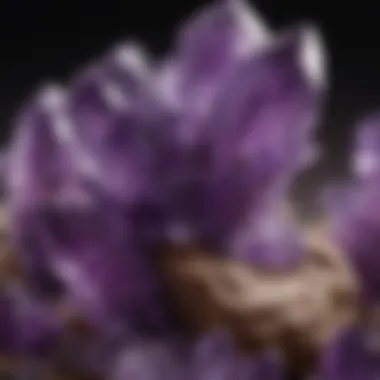
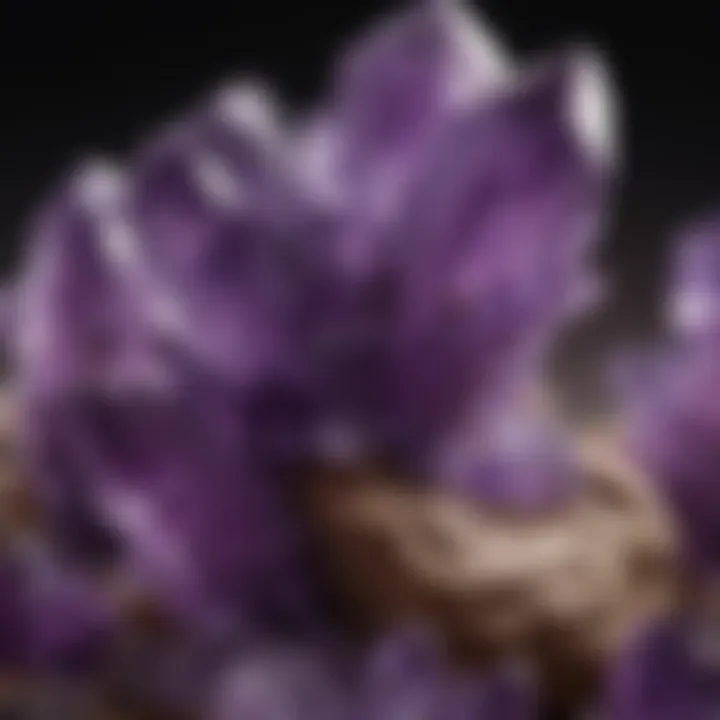
As mineral-rich water seeps into these cavities, the geological tale of the geode begins. Over time, the minerals precipitate from the solution and accumulate on the surfaces of the cavity, leading to the formation of definitive layers. This initial stage is essential as it establishes the framework upon which the amethyst crystals will grow.
"Geodes are wonderful examples of nature's artistry, revealing the potential beauty hidden beneath seemingly ordinary rock surfaces."
Another interesting aspect is the time it takes for a geode to form. This process can span thousands to millions of years, resulting in elaborate crystal formations. The specific environmental conditions during this period contribute to the final appearance of the geode.
Mineralization and Crystal Growth
The mineralization process is where the magic truly happens. As the mineral-rich solution enters the cavity, components such as silicon dioxide are deposited in layers. This is a gradual process, where changes in temperature and pressure can significantly affect crystal development. Amethyst, a purple variation of quartz, forms due to the presence of iron impurities and natural radiation. The color can vary from light lavender to deep violet based on these factors.
During crystal growth, several conditions play a pivotal role:
- Temperature fluctuations: Changes can accelerate or slow down the crystallization process.
- Chemical concentration: The levels of dissolved minerals influence the growth rate and eventual size of the crystals.
- Presence of other minerals: Co-existing minerals can add to the uniqueness of each geode, creating spectacular variations.
Geological Context of Amethyst
Understanding the geological context of amethyst is crucial for comprehending not only its formation but also its significance in the natural world. Geodes containing amethyst crystals originate from specific geological conditions requiring precise temperature and pressure. Thus, determining where amethyst geodes occur can provide insights into the types of environments in which they formed. These insights can benefit collectors and researchers alike as they offer clues to the history of the Earth's crust and the active processes still shaping it today.
Global Locations of Major Finds
Amethyst geodes have been discovered across the globe, but certain regions are notably rich in these formations. Major finds include, but are not limited to:
- Brazil: Known for its large, vibrant amethyst geodes, Brazil’s deposits in Minas Gerais are among the most significant worldwide. Here, geodes can weigh tons and feature striking purple crystals.
- Uruguay: This country is recognized for producing high-quality amethyst with deep color saturation. The Artigas region is especially famous, where amethyst caves yield impressive specimens.
- Spain: The province of Asturias has notable occurrences, with historical geodes having contributed to the understanding of mineralogy in Europe.
- United States: While less abundant, areas like Arizona contain amethyst deposits including notable sites such as the Four Peaks amethyst mine.
These locations not only attract collectors but also serve as research hubs, providing valuable geological data.
Historical Significance
The significance of amethyst geodes extends well beyond their aesthetic appeal. Historically, amethyst played a major role in various cultures. For example, the ancient Greeks believed that amethyst could prevent drunkenness, and they would use it in various forms of adornments. In medieval Europe, amethyst was considered a symbol of morality. It was often worn by clergy and royalty alike, showcasing its esteemed status.
In terms of geology, the study of amethyst geodes has revealed critical information about Earth’s past. For instance, examining the mineral composition can shed light on the environmental conditions during formation, which can be linked to major geological events.
"The study of amethyst is not just about beauty; it’s about unlocking secrets of the Earth's past.”
The cultivation of amethyst also proliferated during the Enlightenment when interest in natural history surged. Collectors began to amass significant specimens, leading to the commercial trade of amethyst geodes. Thus, understanding the historical context of amethyst enhances our appreciation for these natural wonders and informs our current practices in geology and collecting.
Overall, the geological context of amethyst geodes serves as a window into the Earth’s history and showcases the intertwined relationship between geology, culture, and commerce.
Physical Properties of Amethyst Geodes
The physical properties of large amethyst geodes are critical in understanding both their formation and their appeal to collectors and enthusiasts. Amethyst, a variant of quartz, is notable for its rich purple hue and intriguing crystal structures. These properties guide the selection process for collectors and give insight into the geological processes that created these magnificent formations.
Color Variations and Impurities
Amethyst geodes exhibit a spectrum of color variations, primarily determined by the presence of iron and the intensity of radiation exposure during their formation. The shades of purple found in crystals can range from light lavender to deep violet. Some geodes demonstrate striations of white and other colors, indicating the presence of various impurities.
- Iron Content: The amount of iron in the crystal influences the depth of the purple color. Higher iron concentrations generally yield darker hues.
- Irradiation Impact: Natural irradiation can enhance or lighten the color, adding to the uniqueness of each specimen. This variability not only holds aesthetic value but also plays a role in determining market value.
- Common Impurities: Minerals like hematite, which may coexist with amethyst, can create mottled appearances or affect the overall hue of the geode.
Understanding these color variations is essential for enthusiasts when determining the quality and authenticity of amethyst specimens. The depth of color can signal the desirability and sellability of a given geode.
"The color intensity of amethyst crystals can often dictate their market value, making color one of the most scrutinized attributes by collectors."
Crystal Structure and Formation Patterns
The crystal structure of amethyst geodes plays a key role in their allure. Amethyst is characterized by a trigonal crystal system, meaning its atomic arrangement exhibits three-fold symmetry. This symmetry allows for the formation of well-defined, geometric crystal shapes, which enhance the visual appeal of the geodes.
- Drusy Layering: Many amethyst geodes showcase a drusy effect, where tiny, sparkling crystals coat the inner surface of the geode. This phenomenon occurs as crystals grow and fill the cavity over time.
- Formation Patterns: Patterns within the crystal structure, such as growth lines and phantoms, can reveal the history and environmental influences during crystallization. Understanding these patterns adds layers to the narrative of each geode.
In summary, a detailed examination of color variations and crystal structures enhances the appreciation for large amethyst geodes. Collectors benefit from recognizing these properties as they relate to the aesthetic and economic value of their collections.
Cultivating Interest in Amethyst Geodes
Amethyst geodes, with their striking visual appeal and fascinating origins, hold a significant place in the field of mineral collecting. They represent more than just visual aesthetics; they embody natural history and geological processes that span millions of years. Cultivating interest in these formations is essential for both new and seasoned collectors as it broadens their understanding and appreciation of the natural world.
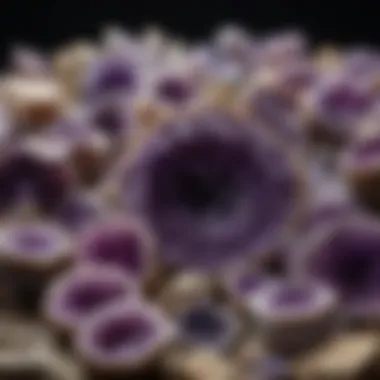

Engaging with amethyst geodes allows enthusiasts to connect with a unique aspect of Earth’s geology. Understanding their formation adds depth to the collecting experience and enhances the value collectors place on their specimens. Knowledge about the geological processes that create these stunning structures can lead to greater appreciation and informed conservation efforts.
Collecting Strategies for Enthusiasts
Collecting amethyst geodes can be both rewarding and challenging. For enthusiasts, developing effective collecting strategies is crucial. First, understanding the sources is key. Locations like Brazil and Uruguay are prominent for high-quality specimens. Exploring these regions can provide insights and opportunities to acquire unique pieces.
- Join Clubs or Online Communities: Engaging with groups centered around mineral collecting can provide valuable tips. Connect with collectors through platforms like Reddit or local rock and mineral clubs.
- Attend Gem Shows: Visiting gem and mineral shows allows collectors to see a variety of specimens. It presents opportunities to meet vendors and other collectors.
- Research before Buying: Gather information on reputable dealers and emerging trends in the market. This knowledge can help avoid common pitfalls and ensure quality over quantity.
Identifying Quality Specimens
To truly enjoy the hobby of collecting amethyst geodes, it is important to learn how to identify quality specimens. Several factors can impact the desirability and value of a geode:
- Color Intensity: The depth and vividness of the purple color can influence its appeal. Rich, vibrant hues are generally more sought after.
- Size and Shape: Large specimens tend to attract more interest, particularly those with unusual shapes or formations. Their unique character can elevate a collection.
- Crystal Clarity: Well-formed crystals with clear surfaces enhance the aesthetic value of the geode. Look for pieces where the crystals appear intact and unblemished.
Care and Preservation of Amethyst Geodes
The care and preservation of amethyst geodes is an essential aspect for collectors and enthusiasts. Proper maintenance can prolong the stunning appearance and integrity of these geological treasures. Understanding how to care for them can make the difference between a well-preserved specimen and one that deteriorates unnecessarily.
To maintain the beauty of large amethyst geodes, it is crucial to consider factors such as cleaning, displaying, and storing. When done correctly, these efforts enhance the visual appeal and protect the geodes from damage caused by environmental factors. The use of proper techniques not only safeguards the specimen but also can potentially increase its market value over time.
Cleaning Techniques
Cleaning amethyst geodes requires a gentle touch and the right approach. Abrasive materials or harsh chemicals can damage the delicate crystals. Here are some recommended techniques:
- Dusting: Regular dusting can prevent buildup. Use a soft, dry microfiber cloth to gently wipe the surface of the geode.
- Water Cleaning: For deeper cleaning, briefly rinse the geode under lukewarm water. Avoid using soap, as it can leave residues.
- Ultrasonic Cleaners: If the geode has a lot of intricate details, some collectors opt for ultrasonic cleaners. These devices can effectively remove dirt without harm if used carefully.
- Disinfection: Occasionally, it’s wise to disinfect, especially if the geode is regularly handled. A mild solution of vinegar and water can work, but ensure to rinse well afterward.
"Regular care prevents irreversible damage. Use caution to maintain their beauty."
Displaying and Storing Practices
Displaying and storing amethyst geodes appropriately is as important as cleaning. The right practices help maintain their condition while allowing them to be appreciated.
- Location: Choose a location away from direct sunlight. Prolonged exposure can fade the vibrant colors of the crystals.
- Humidity Control: Maintain moderate humidity levels. Excess moisture can lead to the growth of mold, while too little can dry out the geode.
- Security: If displaying in a public space or open shelf, secure geodes to prevent accidental falls. Using wall mounts or display cases can be effective.
- Storage: If storing away, use acid-free boxes to prevent chemical reactions. Wrap the geode in a soft cloth to protect it from abrasions. Ensure to keep them upright to prevent any pressure on the crystals.
By integrating these care and preservation techniques into your routine, you can ensure that your large amethyst geodes retain their aesthetic and geological integrity for many years. This not only benefits personal collections but can also enhance their desirability in the market.
Economic and Cultural Implications
The study of large amethyst geodes extends beyond just their geological marvel; it brings forth significant economic and cultural implications. Understanding these factors provides a richer context to the value of amethyst geodes and their role in various cultures and markets.
Market Values and Trade
The market for amethyst geodes can be vibrant and fluctuating. The valuation of these geodes is influenced by multiple factors such as size, color, clarity, and origin. Larger amethyst geodes that display deeper hues of purple, accompanied by transparency and minimal inclusions, tend to command higher prices in the market. Furthermore, the rarity of certain geological locations contributes to the desirability and value of these stones.
Amethyst mining is prominent in regions like Brazil, Uruguay, and Zambia among others. The trade of amethyst geodes often sees these regions recognized for their distinct quality of stones. As the demand rises among collectors and jewelers, the market dynamics change, prompting collectors to stay updated on the latest trends.
Additionally, ethical sourcing has become a pertinent issue. Buyers are increasingly keen on knowing the origin of their amethyst geodes. This awareness influences purchasing decisions, pushing many collectors toward ethically sourced options. Local economies also benefit from this trade, as gemstone mining and selling offer jobs and sustenance to many communities.
Symbolism and Cultural Significance
Amethyst has historically held symbolic value in various cultures. Its deep purple color often associates with luxury and spirituality. Many cultures regard amethyst as a stone of protection and purification. For instance, in ancient Greece, it was believed to guard against intoxication and encourage clear thinking. This belief gave rise to the name 'amethyst,' derived from the Greek word "amethystos," meaning 'not intoxicated.'
In contemporary times, amethyst geodes are often featured in both personal and communal settings. They frequently appear in meditation spaces, where their calming energy is appreciated. Collectors and enthusiasts not only admire their aesthetic beauty but also cherish the spiritual attributes that amethyst represents.
In jewelry design, the use of amethyst is widespread. The stone is featured in rings, necklaces, and bracelets, often symbolizing tranquility and balance. Its rich color is appealing in various styles, from traditional to modern.
"Amethyst geodes embody a fascinating intersection of economic value and cultural heritage, showcasing the deep ties between nature's wonders and human experience."
In summary, the economic and cultural implications surrounding large amethyst geodes are multi-faceted, enriching both the market dynamics and the narrative of human belief and tradition. Engaging with these implications allows collectors to appreciate their assets not only as geological specimens but also as artefacts of cultural significance.
Research and Education on Amethyst Geodes


Research on amethyst geodes holds an important place in the larger context of geology and gemology. The study of these unique formations can deepen our understanding of Earth's processes. To fully appreciate the complexities of large amethyst geodes, both research and education are essential. They shed light on numerous significant aspects such as the methods of formation, geological distributions, and the various properties of amethyst crystals.
Understanding the formation of geodes is crucial. Geodes occur due to mineral-rich water filling cavities in rocks. Over time, crystals form. This natural process reveals insights into geological time scales and environmental conditions. Scientific investigations often yield information about the conditions under which these geodes were formed, enriching knowledge about Earth's history.
Education on this topic encourages enthusiasts and collectors to become knowledgeable about their specimens. With a solid foundation in research, one can understand cultural significance and market values. Education also shapes responsible practices in collecting and trading, ensuring sustainability in the hobby. Thus, this area of study and learning fosters appreciation and respect for these natural wonders.
Geological Studies and Findings
Geological studies of amethyst geodes provide valuable insight into their formation processes. Researchers often examine the mineral compositions and structures. For example, major findings include the locations of famous amethyst deposits, such as those found in Brazil, Uruguay, and South Africa. These studies highlight the geochemical aspects of amethyst formation, revealing factors influencing crystal size and coloration.
Studies also explore the physical aspects of geodes in terms of geological age. This knowledge can influence market demand and collector interest. Scientists often utilize techniques such as electron microprobe analysis and X-ray diffraction to obtain precise data. These advanced methods reveal deeper insights into the geodes' inner structures, guiding enthusiasts in identifying authentic specimens.
"The intricate structures within amethyst geodes can tell us much about the environmental conditions of the past."
Understanding these findings also has implications for mineralogy and geology as a whole. It promotes interdisciplinary approaches combining geology, chemistry, and environmental science, ultimately expanding the horizon on how these natural formations contribute to broader geological knowledge.
Educational Resources for Collectors
Today, various resources exist for collectors eager to learn about amethyst geodes. Books and academic journals provide detailed information about geology and crystal studies. Titles such as "Amethyst: The Smithsonian's Favorite Gem" can serve as excellent starting points.
Online platforms also present excellent educational opportunities. Websites such as Wikipedia or the Encyclopedia Britannica offer summarized insights about the mineral. Social media groups on Facebook and communities on Reddit can facilitate discussions among collectors and enthusiasts. These platforms enable the sharing of resources and experiences related to collecting amethyst geodes.
Additionally, local rock clubs often hold workshops and field trips. These experiences can significantly enhance understanding. Meeting with fellow collectors provides firsthand knowledge about identification, valuation, and preservation techniques.
In sum, ongoing education and research into amethyst geodes enrich the collector experience, contributing to informed collecting practices and a deeper appreciation for Earth's geological wonders.
Future Prospects in Amethyst Research
The significance of the future prospects in amethyst research lies in its potential to enhance both scientific understanding and practical applications concerning these captivating geodes. Ongoing studies could illuminate processes that govern their formation and growth patterns, contributing significantly to geology and crystallography. Furthermore, amethyst geodes can hold insights into Earth’s mineral resources and contribute to sustainable practices in mineral collection.
Emerging Trends in Geode Formation Studies
Emerging research trends are pivotal in expanding the knowledge surrounding geode formation. Recent studies have started to explore the nuances of geological conditions that foster the development of large amethyst geodes. For example, researchers are increasingly focusing on the role of volcanic activity and hydrothermal processes in crystal formation.
Some notable aspects include:
- Geochemical Analysis: Modern analytical techniques allow scientists to examine the geochemical conditions present during the crystallization process, shedding light on why certain regions yield more impressive specimens.
- Stratigraphic Studies: Investigating various layers of rock can yield insights about the environmental changes that lead to the unique characteristics of amethyst geodes.
Such investigations not only enrich geological databases but could also potentially uncover previously unknown locations for future finds.
Technological Advances in Collection and Analysis
Technological innovation continues to revolutionize how collectors and researchers alike approach the study of amethyst geodes. Sophisticated tools now play a vital role in both the collection process and further analytical research.
Advancements include:
- 3D Imaging Technologies: Enables detailed mapping of geode interiors, facilitating a greater understanding of crystal growth patterns without damaging the specimens.
- Advanced Mineralogic Testing: Techniques such as X-ray diffraction and scanning electron microscopy allow for more accurate characterization of minerals and their properties within the geodes.
These technological developments are instrumental in placing scientifically collected data alongside enthusiasm for collecting, merging the worlds of science and hobbyist enthusiasm seamlessly.
Finale
In this article, we have explored the multifaceted nature of large amethyst geodes, emphasizing their distinctive characteristics and geological significance. The discussion ranged from the formation processes of these geodes to their physical properties. Amethyst geodes serve not only as captivating natural formations but also hold cultural, economic, and educational value for collectors and enthusiasts.
Summary of Key Insights
Large amethyst geodes are formed through intricate geological processes over time. Their beauty is derived from the unique purple color and remarkable crystal formations within. Key insights from the article include:
- Formation Process: Geodes form when mineral-rich water fills a hollow cavity in rocks, allowing crystals to grow over time.
- Physical Properties: The color variations in amethyst arise from iron impurities, giving geodes their unique appearance.
- Cultural Significance: Amethyst has been valued for centuries, known for its supposed healing properties and aesthetic appeal.
- Market Values: Collectors should be aware of market trends and values for quality specimens.
These insights provide a fundamental understanding essential for anyone invested in the study or collection of amethyst geodes.
Encouragement for Further Exploration
The realm of amethyst geodes is vast and intriguing. For collectors and enthusiasts, further exploration can yield rewarding experiences. Here are some suggestions for delving deeper:
- Field Research: Investigate local geology and identify locations where amethyst geodes may be found.
- Networking: Join forums and communities, such as the ones found on Reddit and Facebook, to exchange knowledge with other collectors.
- Continued Education: Look for workshops or literature that cover advanced topics in geology and mineral collections.
By continually expanding your understanding of amethyst geodes, you not only enhance your appreciation but also contribute to the broader community of fossil and rock collectors. Engaging with this fascinating subject paves the way for a greater awareness of geological processes and the wonders of natural history.



